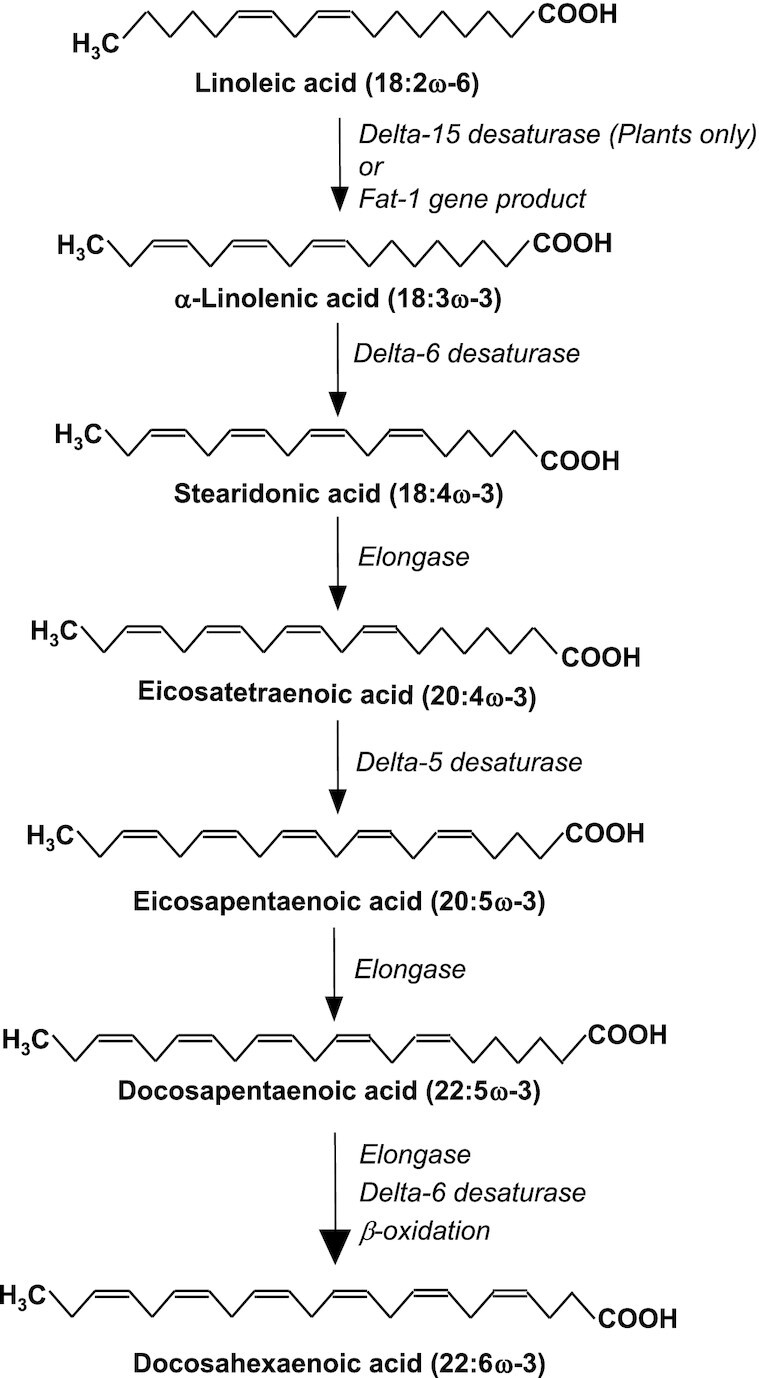Do Endogenously Produced and Dietary ω-3 Fatty Acids Act Differently?
IF 5.1
Q2 CELL BIOLOGY
Function (Oxford, England)
Pub Date : 2023-02-23
eCollection Date: 2023-01-01
DOI:10.1093/function/zqad009
引用次数: 0
Abstract
Omega-3 (ω-3) polyunsaturated fatty acids (PUFAs) are a family of fatty acids distinguished by the presence of the double bond closest to the methyl terminus of the acyl chain being on carbon number 3 counting from the methyl terminal carbon. There are several members of the ω-3 PUFA family. Usually, the most common ω-3 PUFA in the human diet is α-linolenic acid (ALA; 18:3ω-3), an essential fatty acid made in plants from the ω-6 PUFA linoleic acid (LA; 18:2ω-3) by an enzymatic conversion catalyzed by delta-15 desaturase (Figure 1). Animals do not possess the latter enzyme, so they cannot make ALA. Nevertheless, once consumed in the diet, ALA can be converted by animals into long-chain, more unsaturated ω-3 PUFAs, including eicosapentaenoic acid (EPA; 20:5ω-3), docosapentaenoic acid (DPA; 22:5ω-3), and docosahexaenoic acid (DHA: 22:6ω-3) (Figure 1). EPA and DHA are biologically active, influencing cell membrane structure, intracellular signaling pathways, gene expression, and lipid mediator synthesis.1 DPA is less well studied but seems to have similar actions to EPA and DHA. Amongst dietary sources, EPA and DHA are found in the highest amounts in fatty fish; they are also present in fish oil-type supplements. EPA and DHA are linked to many health benefits, including reducing the risk of cardiovascular disease and mortality2; these effects are due to beneficial modification of a number of risk factors.3 There is also evidence that EPA and DHA might reduce the risk of developing nonalcoholic fatty liver disease, through effects on hepatic carbohydrate and fat metabolism and on inflammation.4 In general, case-control studies and longitudinal cohort studies provide stronger evidence for the benefits of EPA and DHA on disease outcomes, with findings from randomized controlled trials in patients at risk of, or already with, disease being inconsistent. Circulating and cell and tissue EPA, DPA, and DHA could come directly from the diet or from endogenous biosynthesis starting with ALA as substrate and using the pathway shown in Figure 1. In people with very low or no intake of seafood and not using supplements that contain EPA, DPA, and DHA, it seems likely that much of the body’s EPA, DPA, and DHA are produced through endogenous biosynthesis.5 Thus, a major role of ALA is as a precursor to its more bioactive ω-3 PUFA derivatives. Endogenous biosynthesis is likely to be downregulated when there is more EPA, DPA, and DHA in the diet.6 However, the relative contributions of diet and endogenous biosynthesis to EPA, DPA, and DHA levels in any compartment or pool within the body are not known. Furthermore, whether the origin of these fatty acids affects their biological action is not well studied. A recent paper published in Function starts to address these questions using murine models.7 Daniel et al.7 use wild-type C57Bl/6 mice and fat-1 mice. The latter are transgenic mice expressing the fat-1 gene from Caenorhabditis elegans, which encodes an enzyme with delta-15 desaturase activity, and so able to convert ω-6 into ω-3 PUFAs.8 Hence, fat-1 mice fed on diets completely lacking any ω-3 PUFAs have significant amounts of ALA, EPA, DPA, and DHA in their blood, cells, and tissues, unlike wild-type mice fed on such

内源性ω-3脂肪酸和膳食ω-3脂肪酸酯的作用不同吗?
本文章由计算机程序翻译,如有差异,请以英文原文为准。
求助全文
约1分钟内获得全文
求助全文

 求助内容:
求助内容: 应助结果提醒方式:
应助结果提醒方式:


